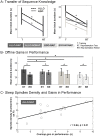Daytime sleep enhances consolidation of the spatial but not motoric representation of motor sequence memory
- PMID: 23300993
- PMCID: PMC3534707
- DOI: 10.1371/journal.pone.0052805
Daytime sleep enhances consolidation of the spatial but not motoric representation of motor sequence memory
Abstract
Motor sequence learning is known to rely on more than a single process. As the skill develops with practice, two different representations of the sequence are formed: a goal representation built under spatial allocentric coordinates and a movement representation mediated through egocentric motor coordinates. This study aimed to explore the influence of daytime sleep (nap) on consolidation of these two representations. Through the manipulation of an explicit finger sequence learning task and a transfer protocol, we show that both allocentric (spatial) and egocentric (motor) representations of the sequence can be isolated after initial training. Our results also demonstrate that nap favors the emergence of offline gains in performance for the allocentric, but not the egocentric representation, even after accounting for fatigue effects. Furthermore, sleep-dependent gains in performance observed for the allocentric representation are correlated with spindle density during non-rapid eye movement (NREM) sleep of the post-training nap. In contrast, performance on the egocentric representation is only maintained, but not improved, regardless of the sleep/wake condition. These results suggest that motor sequence memory acquisition and consolidation involve distinct mechanisms that rely on sleep (and specifically, spindle) or simple passage of time, depending respectively on whether the sequence is performed under allocentric or egocentric coordinates.
Conflict of interest statement
Figures




References
-
- Hikosaka O, Nakahara H, Rand MK, Sakai K, Lu X, et al. (1999) Parallel neural networks for learning sequential procedures. Trends Neurosci 22: 464–471. - PubMed
-
- Hikosaka O, Nakamura K, Sakai K, Nakahara H (2002) Central mechanisms of motor skill learning. Curr Opin Neurobiol 12: 217–222. - PubMed
-
- Nakahara H, Doya K, Hikosaka O (2001) Parallel cortico-basal ganglia mechanisms for acquisition and execution of visuomotor sequences - a computational approach. J Cogn Neurosci 13: 626–647. - PubMed
-
- Nemeth D, Hallgato E, Janacsek K, Sandor T, Londe Z (2009) Perceptual and motor factors of implicit skill learning. Neuroreport 20: 1654–1658. - PubMed
Publication types
MeSH terms
Grants and funding
LinkOut - more resources
Full Text Sources
Other Literature Sources
Medical
Research Materials

